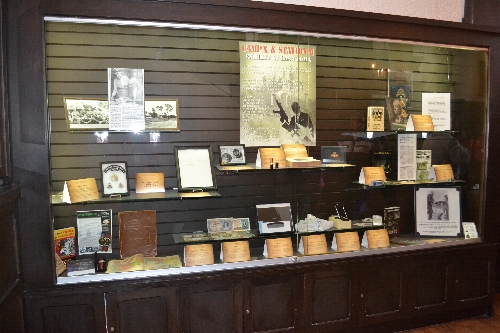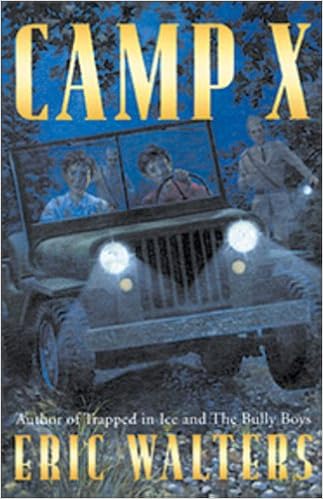MUSEUM MYSTERIES
BY: CHRISTOPHER WAI
Note: The following owes much to Carola Vynhak's invaluable efforts in reporting and following up on the main story below with her many articles as it progressed between 2010 and 2011. It is also absolutely important to recognize Historian Lynn Phillip Hodgson's dedicated and active efforts in keeping Camp X history alive through his website, books and tours.
 |
| X Company, CBC 2015 |
“If you didn't put it in writing, you pretty much gave it to us,” she responded. “Like, hello? How stupid are people?”' -Deirdre Stuart's response to criticism of her sale of the Camp X collection her late father curated.
“This is crazy, man,” beamed collector Bill Steele as he showed off the hefty prize that’s destined for his living room. “Look, there’s just two or three guys bidding. I had a grand to spend and I’ve just spent it.” -Toronto Star
'“I can’t find them anywhere,” she said of the boots and dress tunic her distraught mother hoped she’d retrieve. “She’s disappointed those things will be lost to us. I kind of came to say goodbye.”'- Granddaughter of a veteran looking for her grandfather' possessions.
'“My grandfather wouldn’t have intended this stuff to be sold,” says Smith. “They do not belong to (Deirdre Stuart). This is a Canadian heritage collection and should be treated as such.”'-Cameron SmithToday it's back in the public consciousness through the CBC's X Company drama series, but perhaps it should've come out earlier in 2010 when the Camp X collection was thrown into the winds.
Camp X and the SOE
On Dec. 6, 1941, when Britain the only country left in Western Europe, a day before Pearl Habour and two days before the Battle of Hong Kong (Canada's first battle*) began, Camp X was opened in Whitby/ Oshawa.
It served as the training ground for future paramilitary agents of Britain's Special Operations Executive. The SOE was responsible for conducting espionage, sabotage, demolition, recruitment and providing aid to resistance groups in WW2. It was also home to an important telecommunications network between the Americas and the UK during the war known as HYDRA.
Ian Fleming (creator of James Bond) and Roald Dahl (author of Willy Wonka and the Chocolate Factory) were well known figures who have passed through there and the head of it all, William Stevenson, was an inspiration for James Bond.
 |
| X Company CBC |
The Camp X Collection
In the late 70's or early '80s, Robert Stuart began to collect artifacts from Camp X and belongings from other veterans of the Canadian Army in the local area and they were housed in a city-leased building at the South Field of the Oshawa Airport for around 33 years. But this stasis wouldn't to continue in the end of course.
So it would have been nice if the X Company TV series had been on in 2010 when the large collection of Camp X and other WW2 artifacts were put up for sale by his daughter after his passing.
Many veterans' families were outraged that their parents or grandparents personal belongings, donated in good faith, were to be summarily sold to the highest bidder, their attempts at recovering/ buying them back them scoffed at and rebuffed (see above quote).
It isn't clear how the Ontario Regiment Museum fits into this and whether the donors actually thought they were donating to the museum as Stuart's daughter was the ultimate inheritor despite its place in the institution. Many objects appear to have been given by veterans who were friends or at least on friendly terms with Robert and dependent on “gentlemen's agreements” as opposed to clear documentation of transfers on whether they were or which ones were donations, loans or sales. Deirdre disputed these claims, arguing that they were almost all bought by her father unless proven otherwise and that she had the ultimate ownership over it.
Where Did the Collection Go?
???? Robert Stuart is said to have given away some minor objects (sunglasses, gunbore scope) he had to at least one child.
In 2010, some were put up on eBay for sale, though how many were sold here is unknown. In the same, year, the asking price for the whole collection was 1 million. Deirdre would also later refute that she ever sold objects through eBay.
Around July 2010 Deirdre Stuart donated an oil painting of Canadian fighter pilot and Distinguished Service Order recipient, Lloyd Chadburn to the Oshawa Air Cadets.
November 2010, the Canadian War Museum had bought 15 objects, according to the Toronto Star. This included Historian Lynn Phillip Hodgson's own radio briefcase, which was originally donated for Robert Stuart to curate.
2011. No buyer took the 1 million dollar ask and the bulk of the objects were auctioned off separately at Bruce Kellett’s auction barn in Blackstock, Ontario. Individual collectors and families of veterans were known to have been there. The prices appear to have been fairly low and under their actual value, which perhaps, calls into question why Deirdre didn't simply consult concerned family members.
2012. The “Camp X Collection”, a permanent exhibit was opened at the Regional Municipality of Durham Headquarters with the involvement of Lynn Phillip Hodgson, the most visible and active expert on Camp X's history. See here for more detailed photos:
 |
| Camp X Exhibit at the Regional Municipality of Durham, Camp X Official Site |
2014- A theft occurred at the Durham Region Headquarters and a number of items were stolen from the Camp X collection.
???? Some Camp X artifacts from Lynn Phillip Hodgson's collection may also be found at Casa Loma, titled the "Station M" collection. Casa Loma itself was a sort of "Q lab" of sorts, responsible for preparing hidden compasses, map scarves and forged documents and clothing.
 |
| Casa Loma Station "M" Exhibit, Camp X Official Site |
Wherever most of them are scattered now, which objects came from whom and where probably have no context other than the metonymic militaria found elsewhere in old army surplus shops. Many personal stories and memories that were intrinsically and very clearly tied to these objects were lost in 2011.
I remember being frustrated during my first year of undergrad at the time. I even joined the Facebook group led by historian Lynn Phillip Hodgson and sent out emails to a couple of politicians when someone suggested it though I never did talk to anyone in the group - I was just 18 years old and everything still seemed oddly daunting or awkward, so I mostly lurked. The group also attempted to build a fund to get the whole collection.
But that was then, and the options to mobilize weren't as plentiful.
The almighty power of online crowdfunding platforms and twitter today could have been invaluable and an immediate option now. Granted, the 1 million dollar asking price would still have been far more than would be feasible most likely.
And yet. perhaps with a bigger audience then, there would have been more action or public interest. Documentation kept by both parties would have settled disputes more clearly as well.
Objects and Memory, Forgotten Corners Everywhere...
There are many nuances that get lost and become difficult to research, even if we think we know everything about something as visible as the Second World War.
 |
| Now a four book series apparently.Time to catch up! |
I only learned about the camp though Eric Walters' Camp X novel as a teen as it was never really taught. It's a lot like how the Battle of Hong Kong is forgotten, despite being the first engagement of the war for Canada.
You almost have to stumble on it and often it's not even viewed as relevant or important to many but just a failed defense of a colonial possession (my ancestral home). For me, it is an intrinsic link between both my identities and one that I only learned by coming across the 1505 tombstones (228 Canadian) on the way down from my grandfather's terraced grave. I never asked my grandparents what it was like to be civilians under Japanese or British rule and they've all since passed away.
I have an an old first aid manual and a small byline in a letter from a British medical colleague to my grandfather about living through the war but little context to make any sense of it. One of the few others is a story about my great uncle and aunt, then fiancees, staring down a Japanese soldier, and even that I only learned at his funeral. Still, I suppose I have tangible leads.
At the end of the day, I can't imagine what it’s like for the families who went to auction looking for their parents/ grandparent's belongings- things they thought would be protected and preserved. It may feel mundane to many people, but the memories and objects that were but currency and collectibles to the seller and other buyers meant a lot more in the hands of the families that have lost them completely.
| Sai Wan War Cemetary dedicated to British, Canadian and Indian soldiers who died in the Battle of Hong Kong. Commonwealth War Graves Commission |
Another: Camp 30
There is another related story of Camp 30, a German POW camp which was the site of a POW uprising turned school and survived arson, defacement and potential demolition.
Here are a few links if you are interested:
https://www.thestar.com/opinion/letters_to_the_editors/2013/09/09/students_enjoyed_camp_30.html
https://www.thestar.com/news/ontario/2010/05/24/historic_camp_30_saved_from_wreckers_ball.html
http://www.lfpress.com/2014/11/09/an-insult-to-our-military-history
https://www.thestar.com/news/gta/2009/03/29/blaze_damages_pow_camp.html
https://www.facebook.com/groups/121336101904/
*Technically, Canadian forces entered the battle on Dec. 11, but the battle began on the 8th.
** both headed by the British Security Co-Ordination (BSC)
Editor's Note: A previous edition of this article incorrectly stated that Robert Stuart's artifacts were stored in the Ontario Regiment Museum for 33 years. Mr. Stuart's artifacts were stored in a nearby city-leased building at the South Field of the Oshawa Airport. Musings apologizes for this error.


No comments:
Post a Comment
Note: only a member of this blog may post a comment.